QEP Energy and the Enhanced Reclamation Program
 QEP Energy is an operator that respects and protects the environment. The company has dedicated itself to operating in a safe and environmentally responsible manner. QEP acts to ensure the company meets or exceeds the requirement of environmental laws and other standards, which they voluntarily adopt. QEP works to prevent pollution and respond to any incidents quickly and effectively. They encourage their employees to continually improve environmental performance by providing training and the human, technical, physical, and financial resources to achieve the company’s environmental goals. QEP also finds it important to give back to the communities within which they work and live. QEP Energy is an operator that respects and protects the environment. The company has dedicated itself to operating in a safe and environmentally responsible manner. QEP acts to ensure the company meets or exceeds the requirement of environmental laws and other standards, which they voluntarily adopt. QEP works to prevent pollution and respond to any incidents quickly and effectively. They encourage their employees to continually improve environmental performance by providing training and the human, technical, physical, and financial resources to achieve the company’s environmental goals. QEP also finds it important to give back to the communities within which they work and live.
Putting its philosophy into action, QEP uses an Enhanced Reclamation Program. This program provides guidelines to help ensure successful reclamation following disturbance. QEP’s Senior Biologist, Stephanie Tomkinson, outlined this program in an October 2010 presentation in Vernal, Utah. [Link to presentation here.]
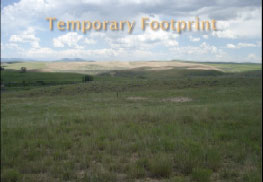 QEP’s Enhanced Reclamation Program QEP’s Enhanced Reclamation Program
QEP’s program involves four primary steps to assure that oil and gas development creates only a temporary footprint on the land. In her presentation, Stephanie Tomkinson explains how her company creates reclamation plans and achieves successful reclamation. She illustrates the program with site-specific examples. Some key aspects of the program are:
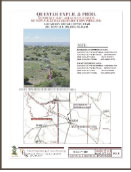
1: Pre-disturbance Planning
During the pre-disturbance phase, QEP sets internal goals and establishes reference sites to be used for purposes of comparison. Information tracking (see monitoring, below) begins at this stage.
2: Recontour and Reclaim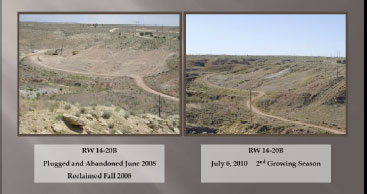
Basic processes in this stage include:
- Empty and backfill reserve pit
- Rip compacted soil
- Recontour
- Spread topsoil
- Establish proper drainage
Practices for minimizing erosion and maximizing water retention, include:
- Snow fences
- Soil amendments (gypsum)
- Straw mulch
- Matting on steep slopes
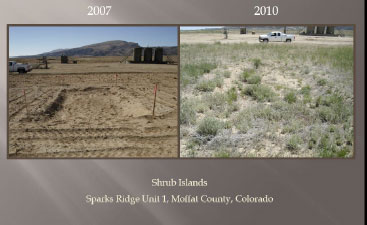
- Imprinting soils
Reclamation enhancements for wildlife and visual quality include:
- Placing shot rock and juniper litter
- Creating shrub islands
- Creating ponds
- Enhancing seed mixes with native shrubs and forbs
3: Monitoring
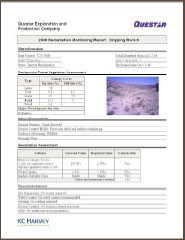 Proper monitoring requires long term tracking and recording of the areas disturbed and reclaimed as well as active areas, seed mix and rate and important dates. Reclamation maps and detailed information on reclamation processes and seed mixes are important for monitoring to be effective. Proper monitoring requires long term tracking and recording of the areas disturbed and reclaimed as well as active areas, seed mix and rate and important dates. Reclamation maps and detailed information on reclamation processes and seed mixes are important for monitoring to be effective.
Monitoring reports include basic site information, quantitative vegetation assessments (both on and off-site), general observations, reclamation assessments and recommendations for remedial action.
4: Remediation (when necessary)
The Enhanced Reclamation Program emphasizes doing it right the first time. But human error and mother nature don’t always cooperate. In these situations, QEP uses their monitoring program to recommend remedial efforts.
Further Research and News Articles
Balancing Resources on the Pinedale Anticline: http://www.papaoperators.com/
QEP Operations Overview: http://qepres.com/ops_overview.html
|

 QEP Energy is an operator that respects and protects the environment. The company has dedicated itself to operating in a safe and environmentally responsible manner. QEP acts to ensure the company meets or exceeds the requirement of environmental laws and other standards, which they voluntarily adopt. QEP works to prevent pollution and respond to any incidents quickly and effectively. They encourage their employees to continually improve environmental performance by providing training and the human, technical, physical, and financial resources to achieve the company’s environmental goals. QEP also finds it important to give back to the communities within which they work and live.
QEP Energy is an operator that respects and protects the environment. The company has dedicated itself to operating in a safe and environmentally responsible manner. QEP acts to ensure the company meets or exceeds the requirement of environmental laws and other standards, which they voluntarily adopt. QEP works to prevent pollution and respond to any incidents quickly and effectively. They encourage their employees to continually improve environmental performance by providing training and the human, technical, physical, and financial resources to achieve the company’s environmental goals. QEP also finds it important to give back to the communities within which they work and live.  QEP’s Enhanced Reclamation Program
QEP’s Enhanced Reclamation Program 


 Proper monitoring requires long term tracking and recording of the areas disturbed and reclaimed as well as active areas, seed mix and rate and important dates. Reclamation maps and detailed information on reclamation processes and seed mixes are important for monitoring to be effective.
Proper monitoring requires long term tracking and recording of the areas disturbed and reclaimed as well as active areas, seed mix and rate and important dates. Reclamation maps and detailed information on reclamation processes and seed mixes are important for monitoring to be effective.